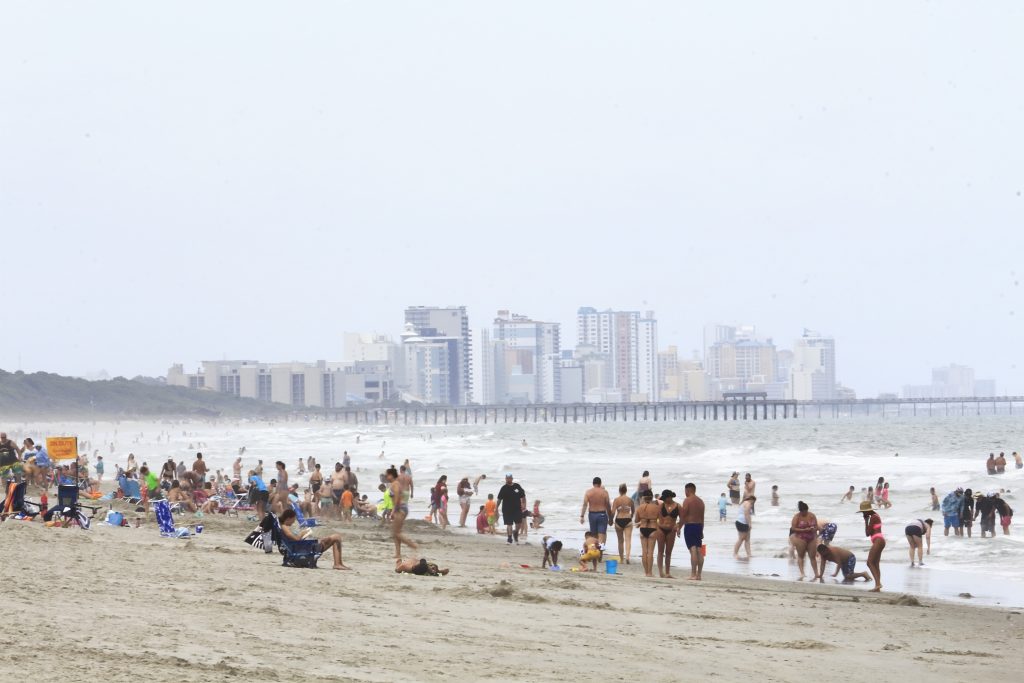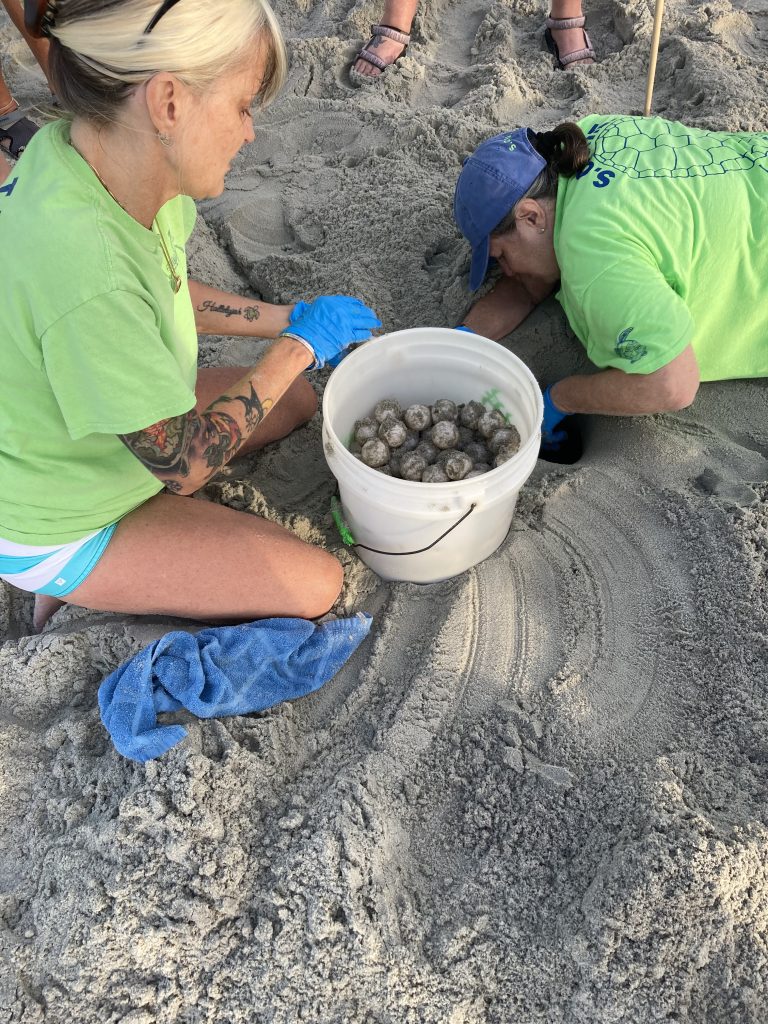The Beach That Was
August 30, 2023By Tom Poland
From afar the skyline looks like that of a city, and it is. Myrtle Beach’s skyline of hotels seems to dwarf the skyline of all other South Carolina cities. It even has a SkyWheel similar to Atlanta’s SkyView Ferris Wheel. Standing on a hot beach gazing at that skyline through humidity and vapors rising from suntan potions, you see no mirage. It’s real, this place of living on the edge—the edge of the continent and the edge of vanishing wildlife habitat.
Two mornings after I photographed the Myrtle Beach skyline from Surfside Beach, my sister, Deb, went out for an early morning walk. Overnight, a loggerhead sea turtle had nested twenty paces north of our dune walkway. She called me as I was on my first cup of coffee. To the beach I went. There the South Carolina United Turtle Enthusiasts, (SCUTES), were hard at work preparing 131 eggs for relocation to a safer place.

Like some mirage the skyline of Myrtle Beach looms over the surf line.
As I stood watching the team, a memory came to me. In the early 1980s I filmed a nesting sea turtle at Cape Romain National Wildlife Refuge, a sprawling National Wildlife Refuge near Awendaw. It was late, around 3 in the morning. We’d been patrolling the beach in a battered jeep—dropped there by a helicopter—looking for the telltale scrape marks that betrayed a female loggerhead turtle’s crawl to the dune line. Deb had just seen that scrape and she knew at once it had to be a nesting female.
“We have a hard time with turtles that want to head up coast toward Myrtle Beach,” a woman told me. A native South Carolinian, I detected pride in her voice but concern in her eyes. How things have changed for God’s creatures along the continent’s edge. In the beginning there was no Grand Strand, no Myrtle Beach, just wet, dense thickets, sand, and swamps. The Waccamaw and Winyah Indians long called this wild land, “Chicora,” translation “the land”.

A SCUTEs volunteer carefully places eggs in the position she finds them.
Time passed and isolation and a weak economy rendered Horry County’s beaches largely uninhabited until the 1900s. Then the Burroughs & Collins Company—a timber/turpentine firm with substantial beachfront property—had an idea. Develop the area as a resort. Swamps would become vacation venues and true sea-level change would come. Chicora gave way to “Long Bay,” “Withers,” or “Withers Big Swamp.” Then the emerging resort area went by “New Town.” That too would change when the Horry Herald sponsored a contest to officially name the area. Mrs. F.E. Burroughs—wife of Burroughs & Collins’s founder—renamed New Town “Myrtle Beach” a tip of the hat to the southern wax myrtle shrub.
Today beach worshipers mob the Grand Strand, I sometimes among them, though I go to be with family and perchance glimpse osprey with fish in their talons and whatever else nature will share. On this trip I saw no porpoises but I put my binoculars on dark elongating shadows, bluefish blitzing toward Garden City.
How I wish I might have seen that nesting sea turtle. The time was right. May through August ushers in the time when sea turtles lumber ashore under darkness to lay eggs in the dunes. Once she begins dropping her eggs she will not budge, a behavior that allowed many a female loggerhead in crueler times to fall victim to poachers who prized turtle meat and eggs.
No poachers, just curious beachcombers. Among them, my sister, daughter, and me. The turtle gave us the highlight of the week, remembering as she did, where she came into this fast-changing world. You could say she too came to a resort, a last resort that’s witnessed massive change.
Georgia native Tom Poland writes a weekly column about the South, its people, traditions, lifestyle, and culture and speaks frequently to groups in the South. Governor Henry McMaster conferred the Order of the Palmetto upon Tom, South Carolina’s highest civilian honor, stating, “His work is exceptional to the state.” Poland’s work appears in books, magazines, journals, and newspapers throughout the South.
Visit Tom’s website at www.tompoland.net
Email him at [email protected]




















